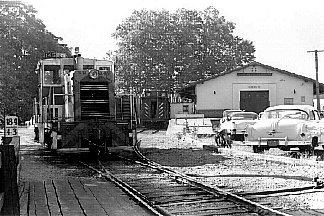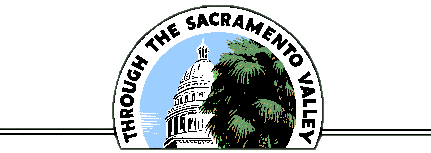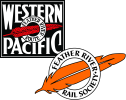CHICO IN THE EARLY DIESEL DAYS
The Sacramento Northern station area in downtown Chico has never received the same attention in the railfan press as Oakland's 40th and Shafter yard. I never understood this and have always thought that the SN in Chico had a certain charm.
I went to high school and college in what has become my hometown of Chico. This was back in the late 1950s and early 1960s, and I passed the downtown station and SN yard almost every day on my way to and from high school. I really didn't pay too much attention to the SN back then. Because of the wisdom of my youth, I didn't see the SN as a real railroad. The real railroad was the Southern Pacific, a few blocks further west. The SP was the line I grew up with in Corning before our family's move to Chico. Talk about your misspent youth!

I did have the presence of mind to take a few pictures and make some notes about the SN back then, and some of this was used in my presentation at the Western Pacific Historical Society convention in Chico in 2006. I've fleshed this out with the encouragement of my friend and fellow SN fan Loren Dunlap.
The SN yard and station in downtown Chico was what I would call a typical interurban station. It had all of the unique features of an interurban: sharp curves, short spurs, and crossings, all necessitated by the compactness of the First and Main location. For those of you unfamiliar with the SN in Chico, you should know that the downtown yard and station were separate from site of the old Mulberry shops further south at 20th and Park Avenue. The old shops became the third and final site for the SN freight station and yard in Chico in the 1960s, and survived to the end of SN operations in the 1980s under Union Pacific ownership.
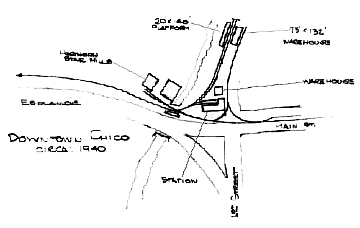
The old passenger station, actually the second at First and Main, was built in an ornate Spanish style with a tile roof, deep overhanging eaves, heavy wooden doors and stucco walls with ornamented corners. Inside was a large freight area, ticket counter, news stand and a small lunch counter. After the end of SN passenger service, the station served Greyhound bus line passengers into the 1960s. I believe that you could even buy California Zephyr tickets there. After the new freight station was built at Mulberry, the passenger station was moved to an industrial park south of Chico, and is still in existence, though in a much modified form.
Just behind and to the north of the passenger station site is Big Chico Creek, which passes under the Esplanade and continues west through the California State University campus. The railroad crossed the creek on a pile trestle parallel to the Esplanade. The trestle was of typical railroad construction, except for one thing: a crossing located right in the middle where the lead to Northern Star Mills on the north side of the creek crossed the lead to the freight station and storage tracks on the creek's south bank. The track to the freight station was in use until the building was moved in the 1960s, and the spur to Northern Star Mills was active until the 1970s.

A little personal story here. I was in Northern Star Mills one day on business. The owner, obviously upset, was ranting to another customer about his shoddy treatment by the SN. Seems an SP boxcar had derailed on their spur, and the SN billed Northern Star Mills for the rerailing and track repair. I think this was the last shipment by rail they ever received.
By the early 1950s the overhead wire was down in Chico, and General Electric 44-tonners were the rule. They were usually parked on the bridge north of the station during the day, since by city ordinance the SN only operated in Chico between 7 p.m. and 7 a.m. due to extensive street running. The locomotives were always shut down, and if you look closely at my picture of 147, you can see an extension cord from the cab out to the power pole to maintain a charge on the batteries [enhanced for clarity -- ed.].
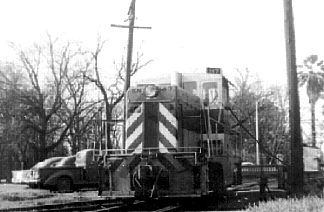
Ernie Von Ibsch III worked in train service for the Western Pacific and the SN starting in the summer of 1965. He told me that some of the 44-tonners had weak batteries, which explained the cord running out of the cab to the power pole. He remembered that one of the 44-tonners failed on the crew one night, so the WP sent two mechanics and an electrician from Oroville to get the locomotive going again. They had never seen a "double-ender" before, but they got the engine going with a hammer and a stick.
Ernie also told me that if they were late on their schedule arriving in Chico after sunrise, the police would threaten the crew with a citation for operating outside the city's time ordinance. He said nobody ever got tagged, as far as he knew, and they never heard anything from corporate headquarters.
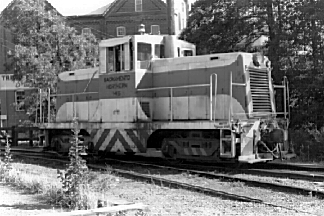
Like every town and city in American back then, on Friday nights almost the entire student body of Chico High School went to the movies. We went to the Senator Theater on Main Street. About eight or nine each evening the building would begin to rumble and shake as the little 44-tonner dragged a seemingly endless string of boxcars out to the airport, adding to the din in the theater coming from the screen or the seats.
Chico in the 1950s and 1960s was an interesting place to come of age for a budding railfan. All the more because of the Sacramento Northern.
